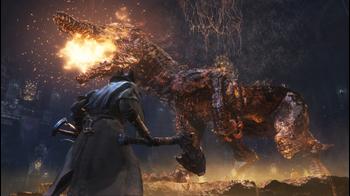Heart and Soul: Setting Bloodborne and Dark Souls apart
The Souls series is engulfed in a bit of an awkward dance right now. While Dark Souls 2 was a commercial and critical success, much of the fanbase felt it was woefully underwhelming in comparison to the first Dark Souls. The disdain for the sequel arose from small but numerous problems, including awkward player tracking on the part of the enemies, unreliable hitboxes, less interesting level design, and a story that was too ambiguous for its own good. Most people attribute the shortcomings of Dark Souls 2 to the fact that series creator Hidetaka Miyazaki was not brought back as the director, who instead went on to direct a new title for Sony Computer Entertainment.
When Sony failed to publish Demon’s Souls in the west, From Software decided to partner with Bandai Namco for the pseudo-sequel Dark Souls. Sony admitted that they “dropped the ball” with the Souls series in what could’ve stayed a major platform exclusive for them. In an attempt to rectify that mistake, Sony approached From Software about a new game which eventually became Bloodborne.
Most of things people loved about the first Dark Souls was once again present in Bloodborne. Brilliant interconnected level design, cohesive blend between the lore and world, fantastic music, and a better emphasis on fairness when it came to difficulty. The most obvious difference between the two is the pace of the combat.
Bloodborne is a game about fast reflexes, while Dark Souls is more about strategy. That is to say despite the reputation for being very difficult, if you have the right tools for the task at hand then Dark Souls will not be that tough. However, recently the lines between what set the two games apart have begun to blur even further. It is apparent that Dark Souls 3 has lifted a good deal of ideas straight from Bloodborne. The combat has noticeably been sped up, and From Software is even incorporating mechanics like charge attacks.
Developers often like to pull mechanics from their recent projects and retrofit them into new titles. A good example being Bioware taking the dialog wheel from Mass Effect and inserting it into the Dragon Age series. In the case of Mass Effect and Dragon Age however, the two games are vastly different from each other in terms of their combat systems, how you build your character (stats), and how their respective worlds are explored.
The same can't really be said for Dark Souls and Bloodborne, Bloodborne is, in part, Sony trying to rectify a mistake made years ago. For all real intents and purposes, Bloodborne is a Souls game, it just doesn't bear the Souls moniker. The gameplay is largely the same, but it is tweaked just enough so it feels different. The themes, story, and worlds are vastly unique, but then again the same could be said for Demon's Souls.
Which brings us to the biggest struggle Dark Souls 3 currently faces: what is it going to do to truly differentiate itself from Bloodborne? Effectively, both franchises are reimaginings of Demon's Souls. At the same time, we see them influencing each other as new releases come out. Not only does Dark Souls 3 share mechanics from Bloodborne, but The Old Hunters expansion lifted some ideas directly from its sister-franchise.
From Software added the Loch Shield and Simon's Bowblade, a defensive shield and a ranged weapon respectively. Both of these, in an odd sort of way, deviate from the heart of what Bloodborne's combat is supposed to be; aggressive, based on counter attacks, and parrying everything you can. While I do think both items blend well into the game and function just fine, I can't help but also feel they further blur the lines as to what makes Bloodborne and Dark Souls different from one another.
